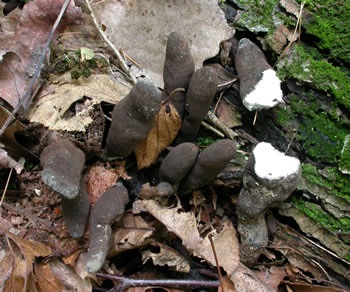How Does Xylaria polymorpha Eat?
Now that one knows X. polymorpha, and other Xylaria, obviously live very near or within plants, one may ask how the fungi receive nutrients from the decaying plant tissue? Just like the white willow (Salix alba) is considered an autotroph, biologists call X. polymorpha a saprobe. Saprobes decompose dead or decaying organic material to abstract their food10. To decompose the plant material, X. polymorpha secretes enzymes onto the wood in front of the tips of its hyphae as the hyphae grow19. Unlike other fungi that decompose the cellulose or lignin components of wood (i.e. white rot and brown rot fungi), X. polymorpha uses its enzymes to break down the glucan and other compounds that serve as glues in the wood18. X. polymorpha then absorbs the newly made smaller molecules, leaving the cellulose and lignin behind18,19. As the mycelium of X. polymorpha digests the glues of the wood, the wood becomes soft, giving fungi like X. polymorpha the title of "soft" rot fungi18.
Did you know that X. polymorpha is not edible22? To learn other fun facts about X. polymorpha, click the link.
